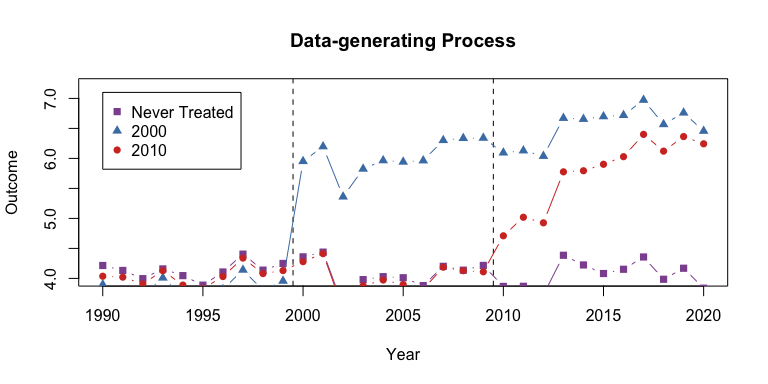
Example data with heterogeneous treatment effects
The hardware and bandwidth for this mirror is donated by METANET, the Webhosting and Full Service-Cloud Provider.
If you wish to report a bug, or if you are interested in having us mirror your free-software or open-source project, please feel free to contact us at mirror[@]metanet.ch.
The goal of did2s is to estimate TWFE models without running into the problem of staggered treatment adoption.
For common issues, see this issue: https://github.com/kylebutts/did2s/issues/12
You can install did2s from CRAN with:
install.packages("did2s")To install the development version, run the following:
devtools::install_github("kylebutts/did2s")For details on the methodology, view this vignette
To view the documentation, type ?did2s into the
console.
The main function is did2s which estimates the two-stage
did procedure. This function requires the following options:
yname: the outcome variablefirst_stage: formula for first stage, can include fixed
effects and covariates, but do not include treatment variable(s)!second_stage: This should be the treatment variable or
in the case of event studies, treatment variables.treatment: This has to be the 0/1 treatment variable
that marks when treatment turns on for a unit. If you suspect
anticipation, see note above for accounting for this.cluster_var: Which variables to cluster onOptional options:
weights: Optional variable to run a weighted first- and
second-stage regressionsbootstrap: Should standard errors be bootstrapped
instead? Default is False.n_bootstraps: How many clustered bootstraps to perform
for standard errors. Default is 250.did2s returns a list with two objects:
I will load example data from the package and plot the average outcome among the groups.
# Automatically loads fixest
library(did2s)
#> Loading required package: fixest
#> did2s (v1.1.0). For more information on the methodology, visit <https://www.kylebutts.github.io/did2s>
#>
#> To cite did2s in publications use:
#>
#> Butts & Gardner, "The R Journal: did2s: Two-Stage
#> Difference-in-Differences", The R Journal, 2022
#>
#> A BibTeX entry for LaTeX users is
#>
#> @Manual{,
#> title = {did2s: Two-Stage Difference-in-Differences Following Gardner (2021)},
#> author = {Kyle Butts and John Gardner},
#> year = {2021},
#> url = {https://journal.r-project.org/articles/RJ-2022-048/},
#> }
# Load Data from R package
data("df_het", package = "did2s")
df_het = as.data.frame(df_het)Here is a plot of the average outcome variable for each of the groups:
# Mean for treatment group-year
agg <- aggregate(df_het$dep_var, by = list(g = df_het$g, year = df_het$year), FUN = mean)
agg$g <- as.character(agg$g)
agg$g <- ifelse(agg$g == "0", "Never Treated", agg$g)
never <- agg[agg$g == "Never Treated", ]
g1 <- agg[agg$g == "2000", ]
g2 <- agg[agg$g == "2010", ]
plot(0, 0,
xlim = c(1990, 2020), ylim = c(3.5, 7.2), type = "n",
main = "Data-generating Process", ylab = "Outcome", xlab = "Year"
)
abline(v = c(1999.5, 2009.5), lty = 2)
lines(never$year, never$x, col = "#8e549f", type = "b", pch = 15)
lines(g1$year, g1$x, col = "#497eb3", type = "b", pch = 17)
lines(g2$year, g2$x, col = "#d2382c", type = "b", pch = 16)
legend(
x = 1990, y = 7.1, col = c("#8e549f", "#497eb3", "#d2382c"),
pch = c(15, 17, 16),
legend = c("Never Treated", "2000", "2010")
)
Example data with heterogeneous treatment effects
First, lets estimate a static did. There are two things to note here.
First, note that I can use fixest::feols formula including
the | for specifying fixed effects and
fixest::i for improved factor variable support. Second,
note that did2s returns a fixest estimate
object, so fixest::etable, fixest::coefplot,
and fixest::iplot all work as expected.
# Static
static <- did2s(
df_het,
yname = "dep_var", first_stage = ~ 0 | state + year,
second_stage = ~ i(treat, ref = FALSE), treatment = "treat",
cluster_var = "state"
)
#> Running Two-stage Difference-in-Differences
#> - first stage formula `~ 0 | state + year`
#> - second stage formula `~ i(treat, ref = FALSE)`
#> - The indicator variable that denotes when treatment is on is `treat`
#> - Standard errors will be clustered by `state`
fixest::etable(static)
#> static
#> Dependent Var.: dep_var
#>
#> treat = TRUE 2.152*** (0.0476)
#> _______________ _________________
#> S.E. type Custom
#> Observations 46,500
#> R2 0.33790
#> Adj. R2 0.33790
#> ---
#> Signif. codes: 0 '***' 0.001 '**' 0.01 '*' 0.05 '.' 0.1 ' ' 1This is very close to the true treatment effect of ~2.23.
Then, let’s estimate an event study did. Note that relative year has
a value of Inf for never treated, so I put this as a
reference in the second stage formula.
# Event Study
es <- did2s(df_het,
yname = "dep_var", first_stage = ~ 0 | state + year,
second_stage = ~ i(rel_year, ref = Inf), treatment = "treat",
cluster_var = "state"
)
#> Running Two-stage Difference-in-Differences
#> - first stage formula `~ 0 | state + year`
#> - second stage formula `~ i(rel_year, ref = Inf)`
#> - The indicator variable that denotes when treatment is on is `treat`
#> - Standard errors will be clustered by `state`And plot the results:
fixest::iplot(es, main = "Event study: Staggered treatment", xlab = "Relative time to treatment", col = "steelblue", ref.line = -0.5, drop = "Inf")
# Add the (mean) true effects
true_effects <- head(tapply((df_het$te + df_het$te_dynamic), df_het$rel_year, mean), -1)
points(-20:20, true_effects, pch = 20, col = "black")
# Legend
legend(
x = -20, y = 3, col = c("steelblue", "black"), pch = c(20, 20),
legend = c("Two-stage estimate", "True effect")
)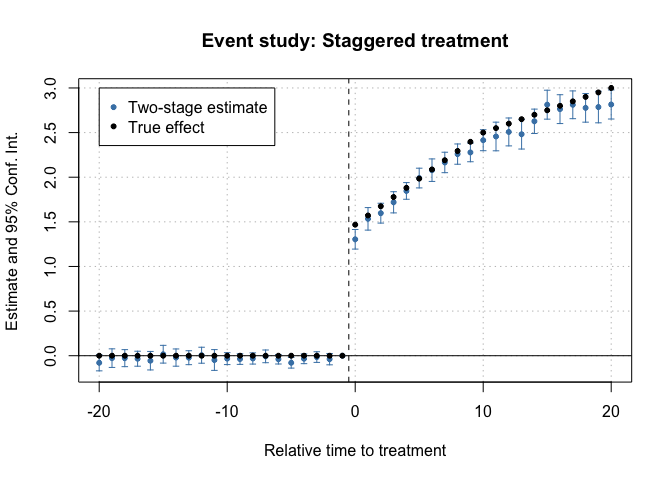
Event-study plot with example data
twfe <- feols(dep_var ~ i(rel_year, ref = c(Inf, -1)) | unit + year, data = df_het)
fixest::iplot(
list(es, twfe),
sep = 0.2, ref.line = -0.5,
col = c("steelblue", "#82b446"), pt.pch = c(20, 18),
xlab = "Relative time to treatment",
main = "Event study: Staggered treatment (comparison)",
drop = "Inf"
)
# Legend
legend(
x = -20, y = 3, col = c("steelblue", "#82b446"), pch = c(20, 18),
legend = c("Two-stage estimate", "TWFE")
)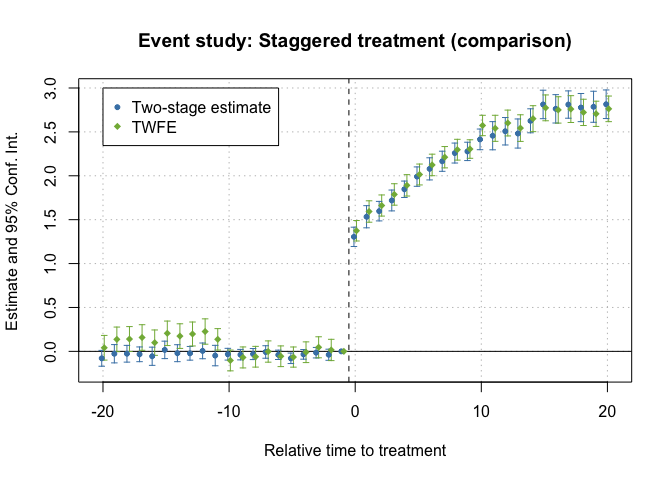
TWFE and Two-Stage estimates of Event-Study
In version 1.1.0, we added support for computing a sensitivity analysis using the approach of Rambachan and Roth (2021).
Here’s an example using data from here.
The provided dataset ehec_data.dta contains a state-level
panel dataset on health insurance coverage and Medicaid expansion. The
variable dins shows the share of low-income childless
adults with health insurance in the state. The variable
yexp2 gives the year that a state expanded Medicaid
coverage under the Affordable Care Act, and is missing if the state
never expanded.
library(HonestDiD)
library(ggplot2)
df <- haven::read_dta("https://raw.githubusercontent.com/Mixtape-Sessions/Advanced-DID/main/Exercises/Data/ehec_data.dta")
df$treated <- ifelse(is.na(df$yexp2), 0, 1 * (df$year >= df$yexp2))
df$rel_year <- ifelse(is.na(df$yexp2), -100, df$year - df$yexp2)
# Estimate did2s
es_did2s <- did2s(
df,
yname = "dins",
first_stage = ~ 0 | stfips + year,
second_stage = ~ 0 + i(rel_year, ref = -100),
treatment = "treated",
cluster_var = "stfips"
)
#> Running Two-stage Difference-in-Differences
#> - first stage formula `~ 0 | stfips + year`
#> - second stage formula `~ 0 + i(rel_year, ref = -100)`
#> - The indicator variable that denotes when treatment is on is `treated`
#> - Standard errors will be clustered by `stfips`
iplot(es_did2s, drop = "-100")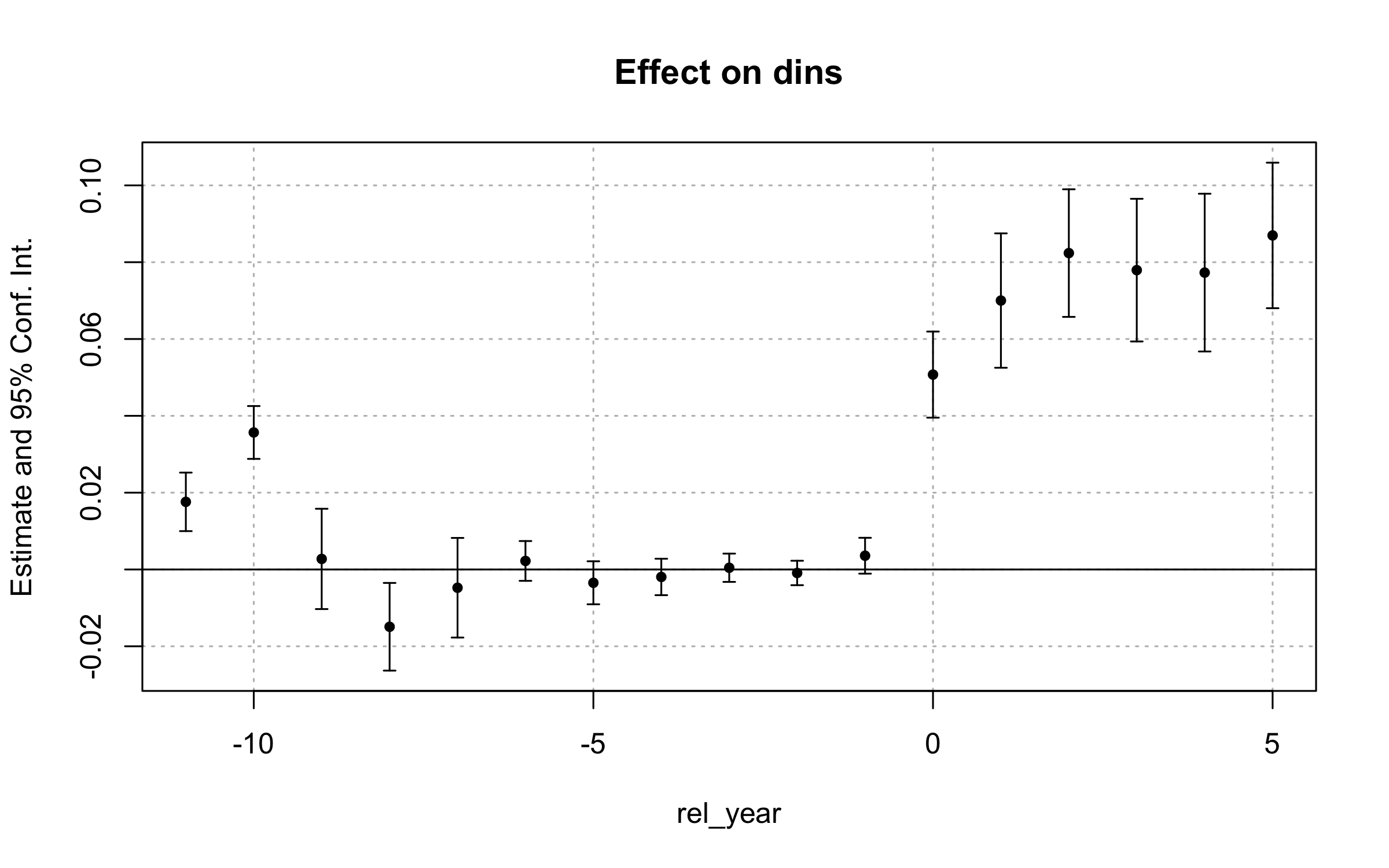
Estimates of the effect of Medicaid expansion on health insurance coverage
# Relative Magnitude sensitivity analysis
sensitivity_results <- es_did2s |>
# Take fixest obj and convert for `honest_did_did2s`
get_honestdid_obj_did2s(coef_name = "rel_year") |>
# Run sensitivity analysis
honest_did_did2s(
e = 0,
type = "relative_magnitude",
Mbarvec = seq(from = 0.5, to = 2, by = 0.5)
)
#> Warning in .ARP_computeCI(betahat = betahat, sigma = sigma, numPrePeriods =
#> numPrePeriods, : CI is open at one of the endpoints; CI length may not be
#> accurate
#> Warning in .ARP_computeCI(betahat = betahat, sigma = sigma, numPrePeriods =
#> numPrePeriods, : CI is open at one of the endpoints; CI length may not be
#> accurate
#> Warning in .ARP_computeCI(betahat = betahat, sigma = sigma, numPrePeriods =
#> numPrePeriods, : CI is open at one of the endpoints; CI length may not be
#> accurate
# Create plot
HonestDiD::createSensitivityPlot_relativeMagnitudes(
sensitivity_results$robust_ci,
sensitivity_results$orig_ci
)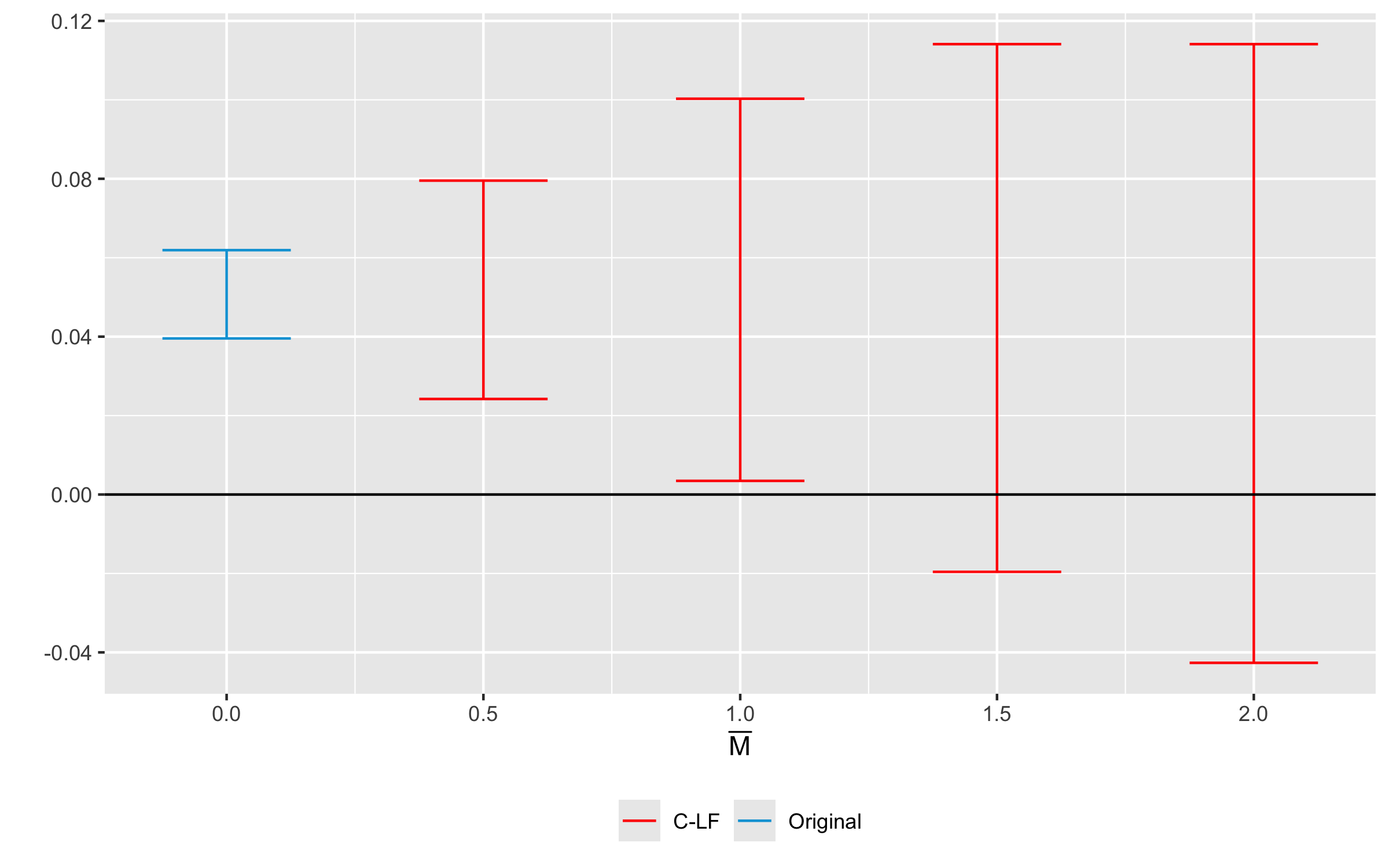
Sensitivity analysis for the example data
library(tidyverse)
#> ── Attaching core tidyverse packages ──────────────────────── tidyverse 2.0.0 ──
#> ✔ dplyr 1.1.4 ✔ readr 2.1.5
#> ✔ forcats 1.0.0 ✔ stringr 1.5.1
#> ✔ lubridate 1.9.3 ✔ tibble 3.2.1
#> ✔ purrr 1.0.2 ✔ tidyr 1.3.1
#> ── Conflicts ────────────────────────────────────────── tidyverse_conflicts() ──
#> ✖ dplyr::filter() masks stats::filter()
#> ✖ dplyr::lag() masks stats::lag()
#> ℹ Use the conflicted package (<http://conflicted.r-lib.org/>) to force all conflicts to become errorsdata(df_het)
df = df_het
multiple_ests = did2s::event_study(
data = df |> mutate(g = ifelse(g == Inf, NA, g)) |> as.data.frame(),
gname = "g",
idname = "unit",
tname = "year",
yname = "dep_var",
estimator = "all"
)
#> Note these estimators rely on different underlying assumptions. See Table 2 of `https://arxiv.org/abs/2109.05913` for an overview.
#> Estimating TWFE Model
#> Estimating using Gardner (2021)
#> Estimating using Callaway and Sant'Anna (2020)
#> Estimating using Sun and Abraham (2020)
#> Estimating using Borusyak, Jaravel, Spiess (2021)
#> Estimating using Roth and Sant'Anna (2021)did2s::plot_event_study(multiple_ests)
Multiple event-study estimators
If you use this package to produce scientific or commercial publications, please cite according to:
citation(package = "did2s")
#> To cite did2s in publications use:
#>
#> Butts & Gardner, "The R Journal: did2s: Two-Stage
#> Difference-in-Differences", The R Journal, 2022
#>
#> A BibTeX entry for LaTeX users is
#>
#> @Manual{,
#> title = {did2s: Two-Stage Difference-in-Differences Following Gardner (2021)},
#> author = {Kyle Butts and John Gardner},
#> year = {2021},
#> url = {https://journal.r-project.org/articles/RJ-2022-048/},
#> }These binaries (installable software) and packages are in development.
They may not be fully stable and should be used with caution. We make no claims about them.